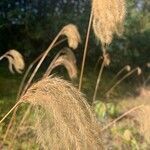Tall robust clumps. Leaf-sheath stiff, ± keeled, often conspicuously purple, with scattered long silky hairs, more densely hairy below collar. Ligule 2-3.5 mm, membranous, obtuse, short-ciliate. Leaf-blade 20-60 cm × 4-10 mm, stiff, flat or folded, gradually tapering, midrib pale green, conspicuous below, abaxially with scattered fine hairs, adaxially glabrous; margins closely, finely scabrid, tip very finely acute. Culm 40-80 cm, stiff, purple-green to yellow-green, nodes purplish, internodes with long fine silky hairs below panicle. Panicle 10-20 cm, golden brown, ± fan-shaped; rachis long silky hairy. Racemes 3.5-10.5 cm, numerous, silky, » panicle rachis. Spikelets numerous; florets ¼-⅓ length of soft, brownish cream, spreading involucral hairs; pedicels purplish, short pedicels = spikelets, long pedicels » spikelets, ± 3-angled. Glumes 1.6-2.8 mm, ± equal, oblong-lanceolate, acute, brownish, finely mucronate or entire, minutely scabrid above on nerves and often purple towards hyaline tip; lower 3-(5)-nerved, margins ciliate, upper 1-(3)-nerved. Lower floret Ø: lemma 1.6-2.6 mm, lanceolate, acute, sparsely, finely prickle-toothed at centre. Upper floret ☿: lemma 1.6-2.2 mm; awn 8.5-11 mm; palea 1-1.5 mm, apex sometimes irregularly bifid; lodicules 0; anthers 1-1.4 mm; gynoecium: ovary 0.5-0.7 mm, stigma-styles 2.6-3 mm; caryopsis 1-1.5 mm. Fig. 24.
More
Plant tufted. Culms erect, 20–200 cm tall, 2–7 mm in diam., glabrous or pilose immediately below inflorescence, nodes glabrous. Leaves basal and cauline; leaf sheaths glabrous, striate, pilose at throat; leaf blades linear, flat or folded, 15–60 × 0.3–2.5 cm, glabrous or pilose, margins scabrid, base tapering, straight or rounded, apex acuminate; ligule 1–3 mm, ciliolate, dorsally pilose. Panicle oblong or equidimensional, 8–24 cm; axis 1.5–16 cm, glabrous. Racemes 7–80, flexuous, 8–18 cm; rachis glabrous; lower pedicel 1–2 mm, upper pedicel 2.5–5.5 mm. Spikelets 2–3 mm, golden brown, awned; callus hairs 5–11 mm, much longer than spikelet, pale to golden brown; glumes subequal or upper slightly longer, membranous, 1–5-veined; lower glume glabrous or margins sparsely pilose with 4–6 mm hairs, apex emarginate; upper glume glabrous, margins and apex hyaline, apex acute; lower lemma ovate, hyaline, 1.5–2 mm, veinless; upper lemma lanceolate, hyaline, 1.5–2 mm; awn straight or flexuous, 5–17 mm; upper palea a ca. 1 mm scale. Anthers 2, 1–1.5 mm. Caryopsis ellipsoid, ca. 1.5 mm.

